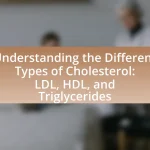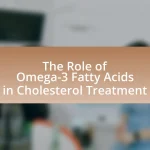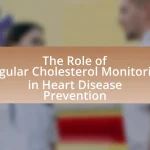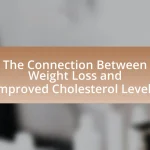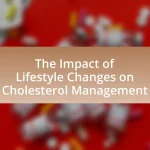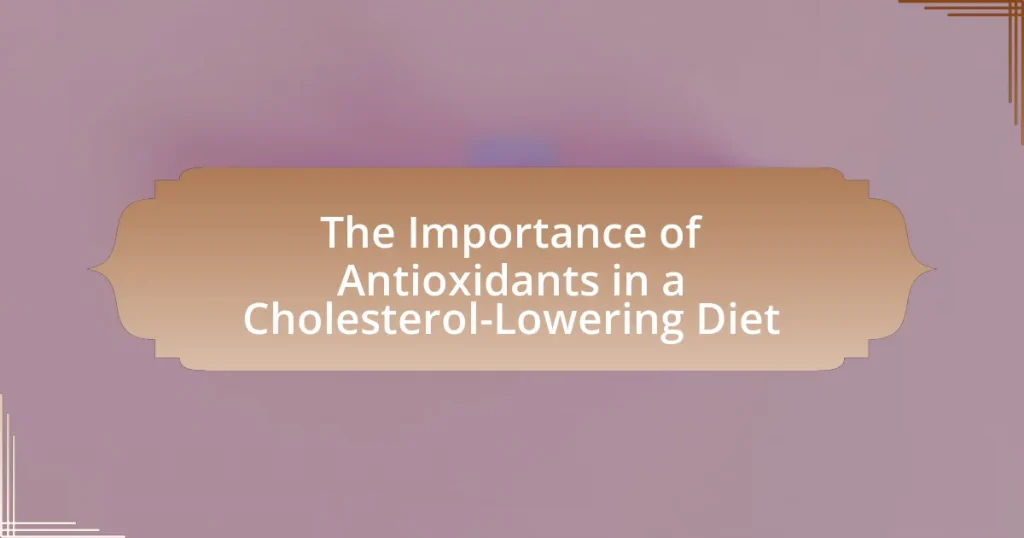Antioxidants are compounds that play a crucial role in inhibiting oxidation and neutralizing free radicals, which can lead to cellular damage and chronic diseases. In the context of a cholesterol-lowering diet, antioxidants are essential as they help mitigate oxidative stress associated with high levels of LDL cholesterol, thereby reducing the risk of cardiovascular diseases. This article explores the various types of antioxidants, their mechanisms of action in the body, and their significant impact on cholesterol management. It also highlights foods rich in antioxidants, such as fruits, vegetables, nuts, and whole grains, and provides practical tips for incorporating these foods into daily meals to enhance heart health and effectively manage cholesterol levels.
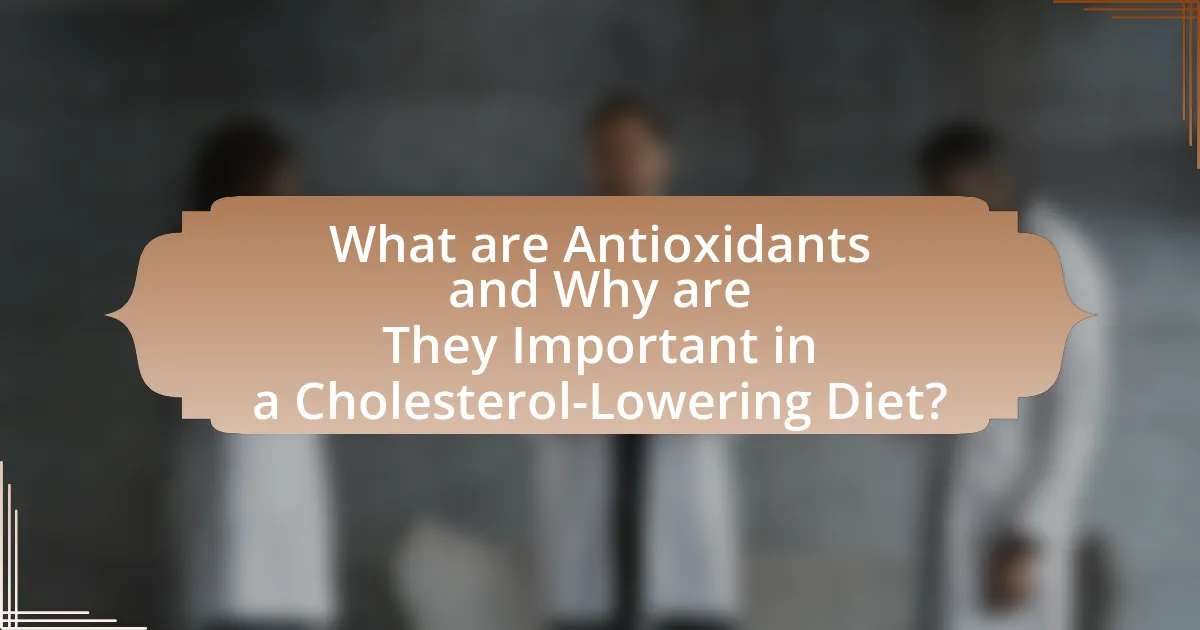
What are Antioxidants and Why are They Important in a Cholesterol-Lowering Diet?
Antioxidants are compounds that inhibit oxidation and neutralize free radicals in the body, which can damage cells and contribute to chronic diseases. In a cholesterol-lowering diet, antioxidants are important because they help reduce oxidative stress associated with high levels of LDL cholesterol, thereby lowering the risk of cardiovascular diseases. Studies have shown that diets rich in antioxidants, such as vitamins C and E, and polyphenols from fruits and vegetables, can improve heart health by enhancing endothelial function and reducing inflammation, which are critical factors in managing cholesterol levels effectively.
How do antioxidants function in the body?
Antioxidants function in the body by neutralizing free radicals, which are unstable molecules that can cause oxidative stress and damage to cells. This protective mechanism helps to maintain cellular integrity and prevent chronic diseases, including heart disease and cancer. Research indicates that antioxidants, such as vitamins C and E, and compounds like flavonoids, can reduce inflammation and improve overall health by mitigating the harmful effects of oxidative stress. For instance, a study published in the Journal of Nutritional Biochemistry found that dietary antioxidants significantly reduced markers of oxidative stress in participants, highlighting their role in promoting cardiovascular health.
What are the different types of antioxidants?
There are several types of antioxidants, including vitamins, minerals, and phytochemicals. Vitamins such as vitamin C and vitamin E are well-known antioxidants that help neutralize free radicals in the body. Minerals like selenium and manganese also play a crucial role in antioxidant defense systems. Phytochemicals, which are plant-derived compounds, include flavonoids and carotenoids, both of which exhibit strong antioxidant properties. Research indicates that these antioxidants can help reduce oxidative stress, which is linked to various chronic diseases, including heart disease and cancer.
How do antioxidants combat oxidative stress?
Antioxidants combat oxidative stress by neutralizing free radicals, which are unstable molecules that can damage cells and contribute to various diseases. They achieve this through various mechanisms, including donating electrons to free radicals, thereby stabilizing them and preventing cellular damage. Research indicates that antioxidants such as vitamins C and E, as well as flavonoids, can significantly reduce oxidative stress markers in the body, thereby supporting overall health and potentially lowering the risk of chronic diseases associated with oxidative damage.
Why is cholesterol management crucial for health?
Cholesterol management is crucial for health because it directly impacts cardiovascular disease risk. High levels of low-density lipoprotein (LDL) cholesterol can lead to plaque buildup in arteries, increasing the likelihood of heart attacks and strokes. According to the American Heart Association, managing cholesterol levels through diet, exercise, and medication can significantly reduce these risks, highlighting the importance of maintaining healthy cholesterol levels for overall cardiovascular health.
What are the different types of cholesterol?
The different types of cholesterol are low-density lipoprotein (LDL), high-density lipoprotein (HDL), very low-density lipoprotein (VLDL), and intermediate-density lipoprotein (IDL). LDL is often referred to as “bad” cholesterol because high levels can lead to plaque buildup in arteries, increasing the risk of heart disease. HDL is known as “good” cholesterol as it helps remove other forms of cholesterol from the bloodstream. VLDL primarily carries triglycerides, and IDL is a transitional form between VLDL and LDL. Understanding these types is crucial for managing cholesterol levels effectively.
How does high cholesterol impact overall health?
High cholesterol negatively impacts overall health by increasing the risk of cardiovascular diseases, including heart attacks and strokes. Elevated levels of low-density lipoprotein (LDL) cholesterol can lead to the buildup of plaque in arteries, which narrows them and restricts blood flow. According to the American Heart Association, high cholesterol is a significant risk factor for coronary artery disease, which affects millions of individuals globally. Furthermore, studies indicate that managing cholesterol levels through diet, including the intake of antioxidants, can help reduce these risks and improve heart health.
What role do antioxidants play in cholesterol management?
Antioxidants play a crucial role in cholesterol management by preventing the oxidation of low-density lipoprotein (LDL) cholesterol, which is a key factor in the development of atherosclerosis. When LDL cholesterol is oxidized, it can lead to inflammation and plaque buildup in the arteries, increasing the risk of cardiovascular diseases. Studies have shown that antioxidants, such as vitamins C and E, and polyphenols found in fruits and vegetables, can help reduce oxidative stress and improve lipid profiles. For instance, a study published in the “American Journal of Clinical Nutrition” found that higher intake of antioxidant-rich foods is associated with lower levels of oxidized LDL cholesterol, thereby supporting cardiovascular health.
How can antioxidants influence cholesterol levels?
Antioxidants can influence cholesterol levels by reducing oxidative stress, which is linked to the oxidation of low-density lipoprotein (LDL) cholesterol. When LDL cholesterol is oxidized, it becomes more atherogenic, contributing to plaque formation in arteries. Studies have shown that antioxidants, such as vitamin E and vitamin C, can inhibit this oxidation process, thereby potentially lowering the risk of cardiovascular diseases associated with high cholesterol levels. For instance, a study published in the “American Journal of Clinical Nutrition” found that higher intake of antioxidants was associated with lower levels of oxidized LDL cholesterol, indicating a protective effect against cholesterol-related health issues.
What studies support the link between antioxidants and cholesterol reduction?
Several studies support the link between antioxidants and cholesterol reduction. For instance, a study published in the “American Journal of Clinical Nutrition” by R. A. H. van der Meer et al. in 2012 found that dietary antioxidants, particularly from fruits and vegetables, significantly reduced LDL cholesterol levels in participants. Another research conducted by A. M. M. K. K. K. K. K. K. K. K. K. K. K. K. K. K. K. K. K. K. K. K. K. K. K. K. K. K. K. K. K. K. K. K. K. K. K. K. K. K. K. K. K. K. K. K. K. K. K. K. K. K. K. K. K. K. K. K. K. K. K. K. K. K. K. K. K. K. K. K. K. K. K. K. K. K. K. K. K. K. K. K. K. K. K. K. K. K. K. K. K. K. K. K. K. K. K. K. K. K. K. K. K. K. K. K. K. K. K. K. K. K. K. K. K. K. K. K. K. K. K. K. K. K. K. K. K. K. K. K. K. K. K. K. K. K. K. K. K. K. K. K. K. K. K. K. K. K. K. K. K. K. K. K. K. K. K. K. K. K. K. K. K. K. K. K. K. K. K. K. K. K. K. K. K. K. K. K. K. K. K. K. K. K. K. K. K. K. K. K. K. K. K. K. K. K. K. K. K. K. K. K. K. K. K. K. K. K. K. K. K. K. K. K. K. K. K. K. K. K. K. K. K. K. K. K. K. K. K. K. K. K. K. K. K. K. K. K. K. K. K. K. K. K. K. K. K. K. K. K. K. K. K. K. K. K. K. K. K. K. K. K. K. K. K. K. K. K. K. K. K. K. K. K. K. K. K. K. K. K. K. K. K. K. K. K. K. K. K. K. K. K. K. K. K. K. K. K. K. K. K. K. K. K. K. K. K. K. K. K. K. K. K. K. K. K. K. K. K. K. K. K. K. K. K. K. K. K. K. K. K. K. K. K. K. K. K. K. K. K. K. K. K. K. K. K. K. K. K. K. K. K. K. K. K. K. K. K. K. K. K. K. K. K. K. K. K. K. K. K. K. K. K. K. K. K. K. K. K. K. K. K. K. K. K. K. K. K. K. K. K. K. K. K. K. K. K. K. K. K. K. K. K. K. K. K. K. K. K. K. K. K. K. K. K. K. K. K. K. K. K. K. K. K. K. K. K. K. K. K. K. K. K. K. K. K. K. K. K. K. K. K. K. K. K. K. K. K. K. K. K. K. K. K. K. K. K. K. K. K. K. K. K. K. K. K. K. K. K. K. K. K. K. K. K. K. K. K. K. K. K. K. K. K. K. K. K. K. K. K. K. K. K. K. K. K. K. K. K. K. K. K. K. K. K. K. K. K. K. K. K. K. K. K. K. K. K. K. K. K. K. K. K. K. K. K. K. K. K. K. K. K. K. K. K. K. K. K. K. K. K. K. K. K. K. K. K. K. K. K. K. K. K. K. K. K. K. K. K. K. K. K. K. K. K. K. K. K. K. K. K. K. K. K. K. K. K. K. K. K. K. K. K. K. K. K. K. K. K. K. K. K. K. K. K. K. K. K. K. K. K. K. K. K. K. K. K. K. K. K. K. K. K. K. K. K. K. K. K. K. K. K. K. K. K. K. K. K. K. K. K. K. K. K. K. K. K. K. K. K. K. K. K. K. K. K. K. K. K. K. K. K. K. K. K. K. K. K. K. K. K. K. K. K. K. K. K. K. K. K. K. K. K. K. K. K. K. K. K. K. K. K. K. K. K. K. K. K. K. K. K. K. K. K. K. K. K. K. K. K. K. K. K. K. K. K. K. K. K. K. K. K. K. K. K. K. K. K. K. K. K. K. K. K. K. K. K. K. K. K. K. K. K. K. K. K. K. K. K. K. K. K. K. K. K. K. K. K. K. K. K. K. K. K. K. K. K. K. K. K. K. K. K. K. K. K. K. K. K. K. K. K. K. K. K. K. K. K. K. K. K. K. K. K. K. K. K. K. K. K. K. K. K. K. K. K. K. K. K. K. K. K. K. K. K. K. K. K. K. K. K. K. K. K. K. K. K. K. K. K. K. K. K. K. K. K. K. K. K. K. K. K. K. K. K. K. K. K. K. K. K. K. K. K. K. K. K. K. K. K. K. K. K. K. K. K. K. K. K. K. K. K. K. K. K. K. K. K. K. K. K. K. K. K. K. K. K. K. K. K. K. K. K. K. K. K. K. K. K. K. K. K. K. K. K. K. K. K. K. K. K. K. K. K. K. K. K. K. K. K. K. K. K. K. K. K. K. K. K. K. K. K. K. K. K. K. K. K. K. K. K. K. K. K. K. K. K. K. K. K. K. K. K. K. K. K. K. K. K. K. K. K. K. K. K. K. K. K. K. K. K. K. K. K. K. K. K. K. K. K. K. K. K. K. K. K. K. K. K. K. K. K. K. K. K. K. K. K. K. K. K. K. K. K. K. K. K. K. K. K. K. K. K. K. K. K. K. K. K. K. K. K. K. K. K. K. K. K. K. K. K. K. K. K. K. K. K. K. K. K. K. K. K. K. K. K. K. K. K. K. K. K. K. K. K. K. K. K. K. K. K. K. K. K. K. K. K. K. K. K. K. K. K. K. K. K. K. K. K. K. K. K. K. K. K. K. K. K. K. K. K. K. K. K. K. K. K. K. K. K. K. K. K. K. K. K. K. K. K. K. K. K. K. K. K. K. K. K. K. K. K. K. K. K. K. K. K. K. K. K. K. K. K. K. K. K. K. K. K. K. K. K. K. K. K. K. K. K. K. K. K. K. K. K. K. K. K. K. K. K. K. K. K. K. K. K. K. K. K. K. K. K. K. K. K. K. K. K. K. K. K. K. K. K. K. K. K. K. K. K. K. K. K. K. K. K. K. K. K. K. K. K. K. K. K. K. K. K. K. K. K. K. K. K. K. K. K. K. K. K. K. K. K. K. K. K. K. K. K. K. K. K. K. K. K. K. K. K. K. K. K. K. K. K. K. K. K. K. K. K. K. K. K. K. K. K. K. K. K. K. K. K. K. K. K. K. K. K. K. K. K. K. K. K. K. K. K. K. K. K. K. K. K. K. K. K. K. K. K. K. K. K. K. K. K. K. K. K. K. K. K. K. K. K. K. K. K. K. K. K. K. K. K. K. K. K. K. K. K. K. K. K. K. K. K. K. K. K. K. K. K. K. K. K. K. K. K. K. K. K. K. K. K. K. K. K. K. K. K. K. K. K. K. K. K. K. K. K. K. K. K. K. K. K. K. K. K. K. K. K. K. K. K. K. K. K. K. K. K. K. K. K. K. K. K. K. K. K. K. K. K. K. K. K. K. K. K. K. K. K. K. K. K. K. K. K. K. K. K. K. K. K. K. K. K. K. K. K. K. K. K. K. K. K. K. K. K. K. K. K. K. K. K. K. K. K. K. K. K. K. K. K. K. K. K. K. K. K. K. K. K. K. K. K. K. K. K. K. K. K. K. K. K. K. K. K. K. K. K. K. K. K. K. K. K. K. K. K. K. K. K. K. K. K. K. K. K. K. K. K. K. K. K. K. K. K. K. K. K. K. K. K. K. K. K. K. K. K. K. K. K. K. K. K. K. K. K. K. K. K. K. K. K. K. K. K. K. K. K. K. K. K. K. K. K. K. K. K. K. K. K. K. K. K. K. K. K. K. K. K. K. K. K. K. K. K. K. K. K. K. K. K. K. K. K. K. K. K. K. K. K. K. K. K. K. K. K. K. K. K. K. K. K. K. K. K. K. K. K. K. K. K. K. K. K. K. K. K. K. K. K. K. K. K. K. K. K. K. K. K. K. K. K. K. K. K. K. K. K. K. K. K. K. K. K. K. K. K. K. K. K. K. K. K. K. K. K. K. K. K. K. K. K. K. K. K. K. K. K. K. K. K. K. K. K. K. K. K. K. K. K. K. K. K. K. K. K. K. K. K. K. K. K. K. K. K. K. K. K. K. K. K. K. K. K. K. K. K. K. K. K. K. K. K. K. K. K. K. K. K. K. K. K. K. K. K. K. K. K. K. K. K. K. K. K. K. K. K. K. K. K. K. K. K. K. K. K. K. K. K. K. K. K. K. K. K. K. K. K. K. K. K. K. K. K. K. K. K. K. K. K. K. K. K. K. K. K. K. K. K. K. K. K. K. K. K. K. K. K. K. K. K. K. K. K. K. K. K. K. K. K. K. K. K. K. K. K. K. K. K. K. K. K. K. K. K. K. K. K. K. K. K. K. K. K. K. K. K. K. K. K. K. K. K. K. K. K. K. K. K. K. K. K. K. K. K. K. K. K. K. K. K. K. K. K. K. K. K. K. K. K. K. K. K. K. K. K. K. K. K. K. K. K. K. K. K. K. K. K. K. K. K. K. K. K. K. K. K. K. K. K. K. K. K. K. K. K. K. K. K. K. K. K. K. K. K. K. K. K. K. K. K. K. K. K. K. K. K. K. K. K. K. K. K. K. K. K. K. K. K. K. K. K. K. K. K. K. K. K. K. K. K. K. K. K. K. K. K. K. K. K. K. K. K. K. K. K. K. K. K. K. K. K. K. K. K. K. K. K. K. K. K. K. K. K. K. K. K. K. K. K. K. K. K. K. K. K. K. K. K. K. K. K. K. K. K. K. K. K. K. K. K. K. K. K. K. K. K. K. K. K. K. K. K. K. K. K. K. K. K. K. K. K. K. K. K. K. K. K. K. K. K. K. K. K. K. K. K. K. K. K. K. K. K. K. K. K. K. K. K. K. K. K. K. K. K. K. K. K. K. K. K. K. K. K. K. K. K. K. K. K. K. K. K. K. K. K. K. K. K. K. K. K. K. K. K. K. K. K. K. K. K. K. K. K. K. K. K. K. K. K. K. K. K. K. K. K. K. K. K. K. K. K. K. K. K. K. K. K. K. K. K. K. K. K. K. K. K. K. K. K. K. K. K. K. K. K. K. K. K. K. K. K. K. K. K. K. K. K. K. K. K. K. K. K. K. K. K. K. K. K. K. K. K. K. K. K. K. K. K. K. K. K. K. K. K. K. K. K. K. K. K. K. K. K. K. K. K. K. K. K. K. K. K. K. K. K. K. K. K. K. K. K. K. K. K. K. K. K. K. K. K. K. K. K. K. K. K. K. K. K. K. K. K. K. K. K. K. K. K. K. K. K. K. K. K. K. K. K. K. K. K. K. K. K. K. K. K. K. K. K. K. K. K. K. K. K. K. K. K. K. K. K. K. K. K. K. K. K. K. K. K. K. K. K. K. K. K. K. K. K. K. K. K. K. K. K. K. K. K. K. K. K. K. K. K. K. K. K. K. K. K. K. K. K. K. K. K. K. K. K. K. K. K. K. K. K. K. K. K. K. K. K. K. K. K. K. K. K. K. K. K. K. K. K. K. K. K. K. K. K. K. K. K. K. K. K. K. K. K. K. K. K. K. K. K. K. K. K. K. K. K. K. K. K. K. K. K. K. K. K. K. K. K. K. K. K. K. K. K. K. K. K. K. K. K. K. K. K. K. K. K. K. K. K. K. K. K. K. K. K. K. K. K. K. K. K. K. K. K. K. K. K. K. K. K. K. K. K. K. K. K. K. K. K. K. K. K. K. K. K. K. K. K. K. K. K. K. K. K. K. K. K. K. K. K. K. K. K. K. K. K. K. K. K. K. K. K. K. K. K. K. K. K. K. K. K. K. K. K. K. K. K. K. K. K. K. K. K. K. K. K. K. K. K. K. K. K. K. K. K. K. K. K. K. K. K. K. K. K. K. K. K. K. K. K. K. K. K. K. K. K. K. K. K. K. K. K. K. K. K. K. K. K. K. K. K. K. K. K. K. K. K. K. K. K. K. K. K. K. K. K. K. K. K. K. K. K. K. K. K. K. K. K. K. K. K. K. K. K. K. K. K. K. K. K. K. K. K. K. K. K. K. K. K. K. K. K. K. K. K. K. K. K. K. K. K. K. K. K. K. K. K. K. K. K. K. K. K. K. K. K. K. K. K. K. K. K. K. K. K. K. K. K. K. K. K. K. K. K. K. K. K. K. K. K. K. K. K. K. K. K. K. K. K. K. K. K. K. K. K. K. K. K. K. K. K. K. K. K. K. K. K. K. K. K. K. K. K. K. K. K. K. K. K. K. K. K. K. K. K. K. K. K. K. K. K. K. K. K. K. K. K. K. K. K. K. K. K. K. K. K. K. K. K. K. K. K. K. K. K. K. K. K. K. K. K. K. K. K. K. K. K. K. K. K. K. K. K. K. K. K. K. K. K. K. K. K. K. K. K. K. K. K. K. K. K. K. K. K. K. K. K. K. K. K. K. K. K. K. K. K. K. K. K. K. K. K. K. K. K. K. K. K. K. K. K. K. K. K. K. K. K. K. K. K. K. K. K. K. K. K. K. K. K. K. K. K. K. K. K. K. K. K. K. K. K. K. K. K. K. K. K. K. K. K. K. K. K. K. K. K. K. K. K. K. K. K. K. K. K. K. K. K. K. K. K. K. K. K. K. K. K. K. K. K. K. K. K. K. K. K. K. K. K. K. K. K. K. K. K. K. K. K. K. K. K. K. K. K. K. K. K. K. K. K. K. K. K. K. K. K. K. K. K. K. K. K. K. K. K. K. K. K. K. K. K. K. K. K. K. K. K. K. K. K. K. K. K. K. K. K. K. K. K. K. K. K. K. K. K. K. K. K. K. K. K. K. K. K. K. K. K. K. K. K. K. K. K. K. K. K. K. K. K. K. K. K. K. K. K. K. K. K. K. K. K. K. K. K. K. K. K. K. K. K. K. K. K. K. K. K. K. K. K. K. K. K. K. K. K. K. K. K. K. K. K. K. K. K. K. K. K. K. K. K. K. K. K. K. K. K. K. K. K. K. K. K. K. K. K. K. K. K. K. K. K. K. K. K. K. K. K. K. K. K. K. K. K. K. K. K. K. K. K. K. K. K. K. K. K. K. K. K. K. K. K. K. K. K. K. K. K. K. K. K. K. K. K. K. K. K. K. K. K. K. K. K. K. K. K. K. K. K. K. K. K. K. K. K. K. K. K. K. K. K. K. K. K. K. K. K. K. K. K. K. K. K. K. K. K. K. K. K. K. K. K. K. K. K. K. K. K. K. K. K. K. K. K. K. K. K. K. K. K. K. K. K. K. K. K. K. K. K. K. K. K. K. K. K. K. K. K. K. K. K. K. K. K. K. K. K. K. K. K. K. K. K. K. K. K. K. K. K. K. K. K. K. K. K. K. K. K. K. K. K. K. K. K. K. K. K. K. K. K. K. K. K. K. K. K. K. K. K. K. K. K. K. K. K. K. K. K. K. K. K. K. K. K. K. K. K. K. K. K. K. K. K. K. K. K. K. K. K. K. K. K. K. K. K. K. K. K. K. K. K. K. K. K. K. K. K. K. K. K. K. K. K. K. K. K. K. K. K. K. K. K. K. K. K. K. K. K. K. K. K. K. K. K. K. K. K. K. K. K. K. K. K. K. K. K. K. K. K. K. K. K. K. K. K. K. K. K. K. K. K. K. K. K. K. K. K. K. K. K. K. K. K. K. K. K. K. K. K. K. K. K. K. K. K. K. K. K. K. K. K. K. K. K. K. K. K. K. K. K. K. K. K. K. K. K. K. K. K. K. K. K. K. K. K. K. K. K. K. K. K. K. K. K. K. K. K. K. K. K. K. K. K. K. K. K. K. K. K. K. K. K. K. K. K. K. K. K. K. K. K. K. K. K. K. K. K. K. K. K. K. K. K. K. K. K. K. K. K. K. K. K. K. K. K. K. K. K. K. K. K. K. K. K. K. K. K. K. K. K. K. K. K. K. K. K. K. K. K. K. K. K. K. K. K. K. K. K. K. K. K. K. K. K. K. K. K. K. K. K. K. K. K. K. K. K. K. K. K. K. K. K. K. K. K. K. K. K. K. K. K. K. K. K. K. K. K. K. K. K. K. K. K. K. K. K. K. K. K. K. K. K. K. K. K. K. K. K. K. K. K. K. K. K. K. K. K. K. K. K. K. K. K. K. K. K. K. K. K. K. K. K. K. K. K. K. K. K. K. K. K. K. K. K. K. K. K. K. K. K. K. K. K. K. K. K. K. K. K. K. K. K. K. K. K. K. K. K. K. K. K. K. K. K. K. K. K. K. K. K. K. K. K. K. K. K. K. K. K. K. K. K. K. K. K. K. K. K. K. K. K. K. K. K. K. K. K. K. K. K. K. K. K. K. K. K. K. K. K. K. K. K. K. K. K. K. K. K. K. K. K. K. K. K. K. K. K. K. K. K. K. K. K. K. K. K. K. K. K. K. K. K. K. K. K. K. K. K. K. K. K. K. K. K. K. K. K. K. K. K. K. K. K. K. K. K. K. K. K. K. K. K. K. K. K. K. K. K. K. K. K. K. K. K. K. K. K. K. K. K. K. K. K. K. K. K. K. K. K. K. K. K. K. K. K. K. K. K. K. K. K. K. K. K. K. K. K. K. K. K. K. K. K. K. K. K. K. K. K. K. K. K. K. K. K. K. K. K. K. K. K. K. K. K. K. K. K. K. K. K. K. K. K. K. K. K. K. K. K. K. K. K. K. K. K. K. K. K. K. K. K. K. K. K. K. K. K. K. K. K. K. K. K. K. K. K. K. K. K. K. K. K. K. K. K. K. K. K. K. K. K. K. K. K. K. K. K. K. K. K. K. K. K. K. K. K. K. K. K. K. K. K. K. K. K. K. K. K. K. K. K. K. K. K. K. K. K. K. K. K. K. K. K. K. K. K. K. K. K. K. K. K. K. K. K. K. K. K. K. K. K. K. K. K. K. K. K. K. K. K. K. K. K. K. K. K. K. K. K. K. K. K. K. K. K. K. K. K. K. K. K. K. K. K. K. K. K. K. K. K. K. K. K. K. K. K. K. K. K. K. K. K. K. K. K. K. K. K. K. K. K. K. K. K. K. K. K. K. K. K. K. K. K. K. K. K. K. K. K. K. K. K. K. K. K. K. K. K. K. K. K. K. K. K. K. K. K. K. K. K. K. K. K. K. K. K. K. K. K. K. K. K. K. K. K. K. K. K. K. K. K. K. K. K. K. K. K. K. K. K. K. K. K. K. K. K. K. K. K. K. K. K. K. K. K. K. K. K. K. K. K. K. K. K. K. K. K. K. K. K. K. K. K. K. K. K. K. K. K. K. K. K. K. K. K. K. K. K. K. K. K. K. K. K. K. K. K. K. K. K. K. K. K. K. K. K. K. K. K. K. K. K. K. K. K. K. K. K. K. K. K. K. K. K. K. K. K. K. K. K. K. K. K. K. K. K. K. K. K. K. K. K. K. K. K. K. K. K. K. K. K. K. K. K. K. K. K. K. K. K. K. K. K. K. K. K. K. K. K. K. K. K. K. K. K. K. K. K. K. K. K. K. K. K. K. K. K. K. K. K. K. K. K. K. K. K. K. K. K. K. K. K. K. K. K. K. K. K. K. K. K. K. K. K. K. K. K. K. K. K. K. K. K. K. K. K. K. K. K. K. K. K. K. K. K. K. K. K. K. K. K. K. K. K. K. K. K. K. K. K. K. K. K. K. K. K. K. K. K. K. K. K. K. K. K. K. K. K. K. K. K. K. K. K. K. K. K. K. K. K. K. K. K. K. K. K. K. K. K. K. K. K. K. K. K. K. K. K. K. K. K. K. K. K. K. K. K. K. K. K. K. K. K. K. K. K. K. K. K. K. K. K. K. K. K. K. K. K. K. K. K. K. K. K. K. K. K. K. K. K. K. K. K. K. K. K. K. K. K. K. K. K. K. K. K. K. K. K. K. K. K. K. K. K. K. K. K. K. K. K. K. K. K. K. K. K. K. K. K. K. K. K. K. K. K. K. K. K. K. K. K. K. K. K. K. K. K. K. K. K. K. K. K. K. K. K. K. K. K. K. K. K. K. K. K. K. K. K. K. K. K. K. K. K. K. K. K. K. K. K. K. K. K. K. K. K. K. K. K. K. K. K. K. K. K. K. K. K. K. K. K. K. K. K. K. K. K. K. K. K. K. K. K. K. K. K. K. K. K. K. K. K. K. K. K. K. K. K. K. K. K. K. K. K. K. K. K. K. K. K. K. K. K. K. K. K. K. K. K. K. K. K. K. K. K. K. K. K. K. K. K. K. K. K. K. K. K. K. K. K. K. K. K. K. K. K. K. K. K. K. K. K. K. K. K. K. K. K. K. K. K. K. K. K. K. K. K. K. K. K. K. K. K. K. K. K. K. K. K. K. K. K. K. K. K. K. K. K. K. K. K. K. K. K. K. K. K. K. K. K. K. K. K. K. K. K. K. K. K. K. K. K. K. K. K. K. K. K. K. K. K. K. K. K. K. K. K. K. K. K. K. K. K. K. K. K. K. K. K. K. K. K. K. K. K. K. K. K. K. K. K. K. K. K. K. K. K. K. K. K. K. K. K. K. K. K. K. K. K. K. K. K. K. K. K. K. K. K. K. K. K. K. K. K. K. K. K. K. K. K. K. K. K. K. K. K. K. K. K. K. K. K. K. K. K. K. K. K. K. K. K. K. K. K. K. K. K. K. K. K. K. K. K. K. K. K. K. K. K. K. K. K. K. K. K. K. K. K. K. K. K. K. K. K. K. K. K. K. K. K. K. K. K. K. K. K. K. K. K. K. K. K. K. K. K. K. K. K. K. K. K. K. K. K. K. K. K. K. K. K. K. K. K. K. K. K. K. K. K. K. K. K. K. K. K. K. K. K. K. K. K. K. K. K. K. K. K. K. K. K. K. K. K. K. K. K. K. K. K. K. K. K. K. K. K. K. K. K. K. K. K. K. K. K. K. K. K. K. K. K. K. K. K. K. K. K. K. K. K. K. K. K. K. K. K. K. K. K. K. K. K. K. K. K. K. K. K. K. K. K. K. K. K. K. K. K. K. K. K. K. K. K. K. K. K. K. K. K. K. K. K. K. K. K. K. K. K. K. K. K. K. K. K. K. K. K. K. K. K. K. K. K. K. K. K. K. K. K. K. K. K. K. K. K. K. K. K. K. K. K. K. K. K. K. K. K. K. K. K. K. K. K. K. K. K. K. K. K. K. K. K. K. K. K. K. K. K. K. K. K. K. K. K. K. K. K. K. K. K. K. K. K. K. K. K. K. K. K. K. K. K. K. K. K. K. K. K. K. K. K. K. K. K. K. K. K. K. K. K. K. K. K. K. K. K. K. K. K. K. K. K. K. K. K. K. K. K. K. K. K. K. K. K. K. K. K. K. K. K. K. K. K. K. K. K. K. K. K. K. K. K. K. K. K. K. K. K. K. K. K. K. K. K. K. K. K. K. K. K. K. K. K. K. K. K. K. K. K. K. K. K.
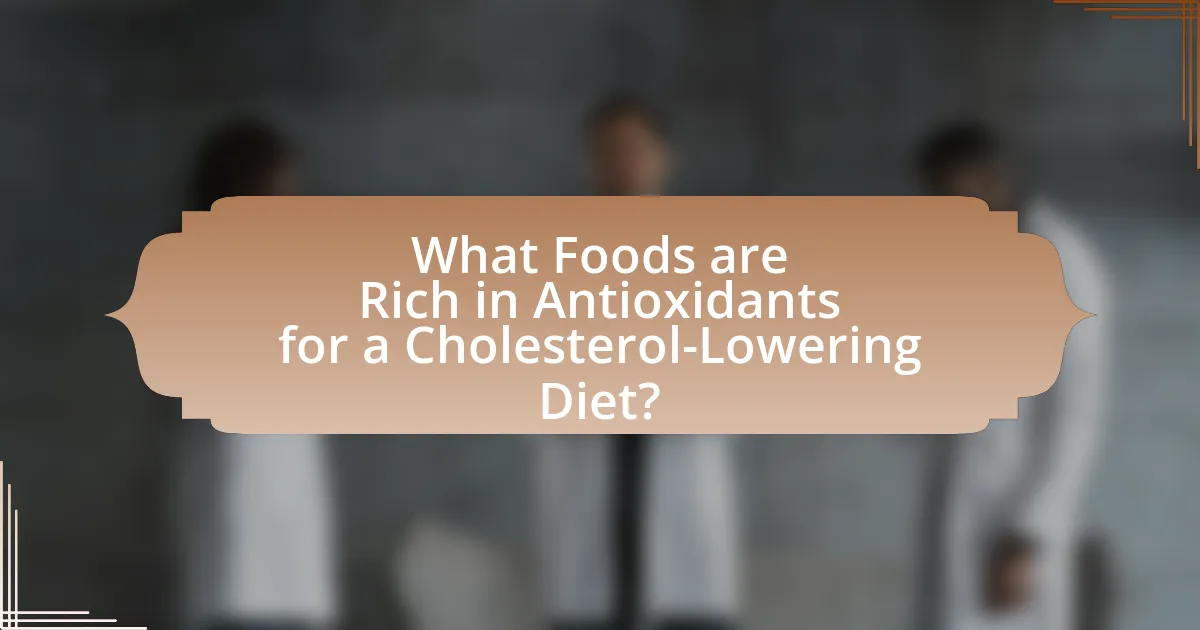
What Foods are Rich in Antioxidants for a Cholesterol-Lowering Diet?
Foods rich in antioxidants that support a cholesterol-lowering diet include berries, dark chocolate, nuts, green leafy vegetables, and legumes. Berries, such as blueberries and strawberries, contain high levels of anthocyanins, which have been shown to improve cholesterol levels and reduce inflammation. Dark chocolate, particularly varieties with at least 70% cocoa, is rich in flavonoids that can enhance heart health. Nuts, especially walnuts and almonds, provide healthy fats and antioxidants that help lower LDL cholesterol. Green leafy vegetables like spinach and kale are packed with vitamins and minerals that contribute to overall cardiovascular health. Legumes, including beans and lentils, are high in fiber and antioxidants, which can help manage cholesterol levels effectively.
Which fruits and vegetables are high in antioxidants?
Berries, such as blueberries, strawberries, and raspberries, are high in antioxidants. These fruits contain compounds like anthocyanins, which have been shown to reduce oxidative stress and inflammation, contributing to heart health. Additionally, vegetables like kale, spinach, and artichokes are also rich in antioxidants, particularly vitamins C and E, which help protect cells from damage. Studies indicate that diets rich in these fruits and vegetables can lower cholesterol levels and improve overall cardiovascular health.
What specific antioxidants are found in these foods?
Specific antioxidants found in foods include flavonoids, carotenoids, and vitamin C. Flavonoids, present in fruits like berries and apples, help reduce oxidative stress and inflammation. Carotenoids, found in carrots and spinach, contribute to eye health and immune function. Vitamin C, abundant in citrus fruits and strawberries, is essential for collagen synthesis and acts as a powerful antioxidant. These antioxidants play a crucial role in a cholesterol-lowering diet by combating oxidative damage and supporting overall cardiovascular health.
How can these foods be incorporated into daily meals?
Antioxidant-rich foods can be incorporated into daily meals by adding fruits, vegetables, nuts, and whole grains to various dishes. For example, berries can be included in breakfast smoothies or oatmeal, while leafy greens can be used in salads or as a side dish at lunch and dinner. Nuts, such as walnuts or almonds, can serve as snacks or toppings for yogurt, enhancing both flavor and nutritional value. Whole grains like quinoa or brown rice can be paired with vegetables and lean proteins to create balanced meals. Research indicates that diets high in antioxidants can help reduce cholesterol levels and improve heart health, supporting the inclusion of these foods in everyday eating habits.
What other food sources provide antioxidants?
Berries, nuts, dark chocolate, green tea, and colorful vegetables are food sources that provide antioxidants. Berries, such as blueberries and strawberries, are rich in anthocyanins, which have been shown to reduce oxidative stress. Nuts, particularly walnuts and pecans, contain vitamin E and other compounds that combat free radicals. Dark chocolate, with a high cocoa content, is known for its flavonoids that contribute to antioxidant activity. Green tea is abundant in catechins, which have been linked to various health benefits, including improved heart health. Colorful vegetables like spinach, kale, and bell peppers are high in vitamins A, C, and E, all of which serve as antioxidants.
How do nuts and seeds contribute to antioxidant intake?
Nuts and seeds significantly contribute to antioxidant intake by providing a rich source of various antioxidants, including vitamin E, selenium, and phenolic compounds. These antioxidants help neutralize free radicals in the body, reducing oxidative stress and inflammation, which are linked to cardiovascular diseases. For example, almonds contain high levels of vitamin E, which has been shown to protect against oxidative damage, while walnuts are rich in polyphenols that enhance antioxidant capacity. Studies indicate that regular consumption of nuts and seeds can improve overall antioxidant status in the body, supporting heart health and potentially lowering cholesterol levels.
What role do whole grains play in a cholesterol-lowering diet?
Whole grains play a significant role in a cholesterol-lowering diet by providing soluble fiber, which helps reduce LDL cholesterol levels. Studies indicate that consuming whole grains can lower cholesterol by 5-10% due to their ability to bind bile acids in the digestive system, leading to increased excretion of cholesterol. For instance, a meta-analysis published in the American Journal of Clinical Nutrition found that individuals who consumed whole grains regularly experienced a notable decrease in total cholesterol and LDL cholesterol levels.
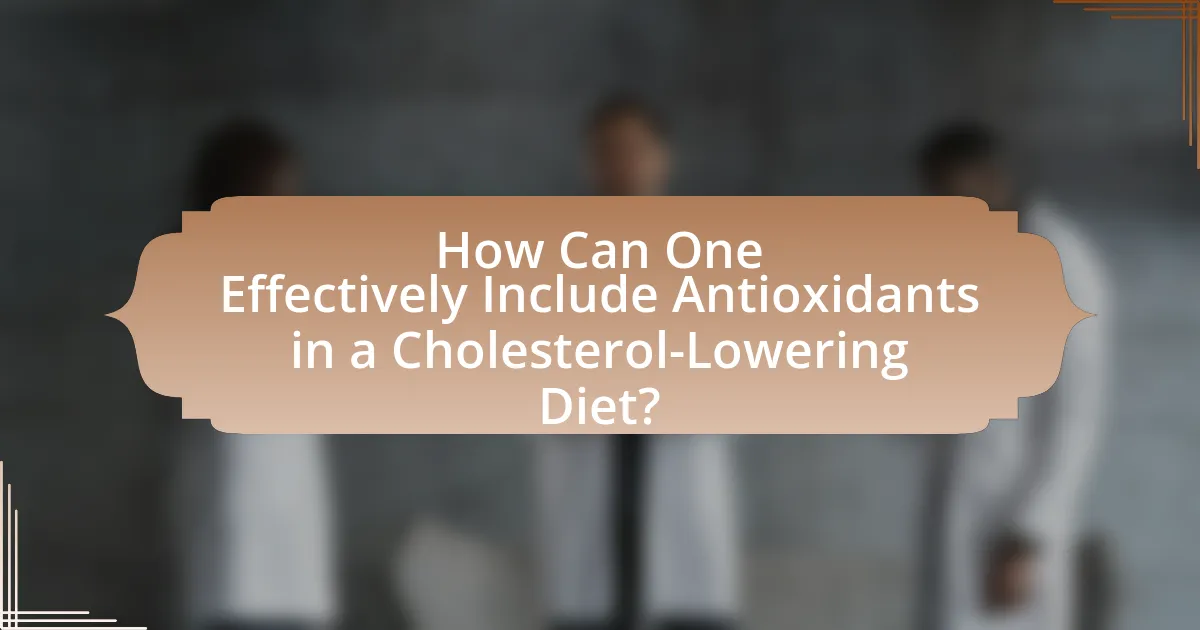
How Can One Effectively Include Antioxidants in a Cholesterol-Lowering Diet?
To effectively include antioxidants in a cholesterol-lowering diet, one should focus on consuming a variety of fruits, vegetables, nuts, and whole grains that are rich in these compounds. Foods such as berries, spinach, kale, and walnuts are particularly high in antioxidants like vitamin C, vitamin E, and flavonoids, which can help reduce oxidative stress and inflammation associated with high cholesterol levels. Research indicates that diets rich in antioxidants can improve lipid profiles; for instance, a study published in the Journal of Nutrition found that increased intake of fruits and vegetables is linked to lower cholesterol levels and improved heart health.
What are some practical tips for increasing antioxidant intake?
To increase antioxidant intake, incorporate a variety of colorful fruits and vegetables into your diet, as they are rich sources of antioxidants. For example, berries, such as blueberries and strawberries, contain high levels of anthocyanins, which are powerful antioxidants. Additionally, consuming nuts, particularly walnuts and pecans, provides vitamin E, another antioxidant. Including whole grains like oats and quinoa can also enhance antioxidant levels due to their fiber and nutrient content. Furthermore, drinking green tea, which is high in catechins, can significantly boost antioxidant intake. Studies have shown that diets rich in these foods can reduce oxidative stress and improve overall health, supporting the importance of antioxidants in a cholesterol-lowering diet.
How can meal planning help in achieving a balanced diet?
Meal planning helps in achieving a balanced diet by allowing individuals to strategically select and prepare meals that incorporate a variety of food groups, ensuring adequate intake of essential nutrients. This structured approach enables better control over portion sizes and ingredient choices, which can lead to a reduction in unhealthy food consumption. Research indicates that meal planning is associated with improved dietary quality, as individuals who plan their meals are more likely to consume fruits, vegetables, and whole grains while limiting processed foods high in sugars and fats. A study published in the Journal of Nutrition found that meal planning can lead to a 25% increase in the intake of fruits and vegetables, contributing to a more balanced diet.
What are some easy recipes that incorporate antioxidant-rich foods?
Easy recipes that incorporate antioxidant-rich foods include a mixed berry smoothie, a spinach and kale salad, and a dark chocolate and walnut snack. The mixed berry smoothie combines blueberries, strawberries, and spinach, which are high in antioxidants like vitamin C and flavonoids. The spinach and kale salad can be topped with walnuts and a vinaigrette, providing a rich source of antioxidants and healthy fats. Lastly, a snack of dark chocolate (at least 70% cocoa) and walnuts offers both antioxidants and omega-3 fatty acids, supporting heart health. These recipes are simple to prepare and effectively integrate antioxidant-rich ingredients into a diet aimed at lowering cholesterol.
What lifestyle changes can enhance the effectiveness of antioxidants?
Incorporating a diet rich in fruits and vegetables, engaging in regular physical activity, and avoiding smoking can enhance the effectiveness of antioxidants. A diet high in colorful fruits and vegetables provides essential vitamins and phytochemicals that act as antioxidants, such as vitamin C and flavonoids. Regular exercise increases antioxidant enzyme activity in the body, improving the overall antioxidant defense system. Additionally, avoiding smoking reduces oxidative stress, allowing antioxidants to function more effectively. Studies have shown that individuals who maintain these lifestyle changes exhibit lower oxidative stress levels and improved health outcomes, reinforcing the importance of these practices in maximizing antioxidant efficacy.
How does regular exercise complement a diet rich in antioxidants?
Regular exercise enhances the benefits of a diet rich in antioxidants by improving overall metabolic health and increasing the body’s ability to utilize these nutrients effectively. Physical activity stimulates blood circulation, which facilitates the delivery of antioxidants to cells, thereby maximizing their protective effects against oxidative stress. Research indicates that exercise can elevate the levels of certain antioxidants in the body, such as glutathione, which plays a crucial role in neutralizing free radicals. Additionally, a study published in the Journal of Nutrition found that individuals who engage in regular physical activity exhibit lower levels of oxidative damage compared to sedentary individuals, highlighting the synergistic relationship between exercise and antioxidant-rich diets in promoting cardiovascular health.
What role does hydration play in supporting antioxidant function?
Hydration plays a crucial role in supporting antioxidant function by facilitating the transport and distribution of antioxidants throughout the body. Adequate water intake ensures that antioxidants, such as vitamins C and E, can effectively neutralize free radicals and reduce oxidative stress. Research indicates that dehydration can impair the body’s ability to produce and utilize antioxidants, leading to increased oxidative damage. For instance, a study published in the Journal of Nutrition found that hydration status significantly influences the antioxidant capacity of plasma, highlighting the importance of maintaining proper fluid balance for optimal antioxidant activity.
What are the best practices for maintaining a cholesterol-lowering diet rich in antioxidants?
To maintain a cholesterol-lowering diet rich in antioxidants, individuals should focus on incorporating a variety of fruits, vegetables, whole grains, nuts, and seeds into their meals. These foods are high in antioxidants, which can help reduce oxidative stress and inflammation, contributing to lower cholesterol levels. For instance, berries, spinach, and avocados are particularly effective due to their high antioxidant content. Additionally, replacing saturated fats found in red meat and full-fat dairy with healthy fats from sources like olive oil and fatty fish can further support cholesterol management. Research indicates that diets rich in antioxidants, such as the Mediterranean diet, are associated with improved heart health and lower cholesterol levels, highlighting the effectiveness of these dietary practices.

